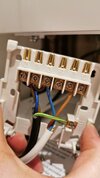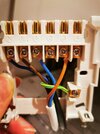I kept it on for over an hour to determine whether or not it was the delay of the app/thermostat. Neither can turn the boiler off on commandSo, how long have you left it running to determine it's not turning off?
You are using an out of date browser. It may not display this or other websites correctly.
You should upgrade or use an alternative browser.
You should upgrade or use an alternative browser.
Hive thermostat installation
- Thread starter Red316
- Start date
The Hive receiver is only a switch. It simply connects and disconnects the two wires on terminals one and three.
You could try removing the receiver once the boiler has turned on (be careful, as the contacts on the backplate will be live).
If the boiler turns off (after a short overrun), the Hive/receiver may be at fault. If the boiler still doesn't turn off, the problem could be with your boiler/wiring.
You could try removing the receiver once the boiler has turned on (be careful, as the contacts on the backplate will be live).
If the boiler turns off (after a short overrun), the Hive/receiver may be at fault. If the boiler still doesn't turn off, the problem could be with your boiler/wiring.
D
Deleted member 267285
Yep, sounds more like a boiler/thermostat/wiring issue, than just the app.
When I turn the switch on, with the wired settings I've attached, the boiler starts up automatically and stays on. Whatever I do on the app/thermostat it won't turn the boiler off, but I'm convinced i can't be the wiring if you guys suggest it's ok.Yep, sounds more like a boiler/thermostat/wiring issue, than just the app
I'm using a Biasi combi boiler and the hive receiver is a Dual Channel receiver wiring, not sure what else to do from here
Attachments
That would explain it.I'm using a Biasi combi boiler and the hive receiver is a Dual Channel receiver wiring, not sure what else to do from here
Why do you have a dual channel Hive, when your original controller was single channel and you have a combi?
You've also added an unnecessary link between L and 1.
Ps. Single channel Hive was mentioned in post#2!
Note to self, always ask if the Hive is single or dual channel...
Last edited:
D
Deleted member 267285
Yep, this time assume did make an ass of u and me!Note to self, always ask if the Hive is single or dual channel...
Actually when I bought it there was no mention of single or double it was just...hive thermostatThat would explain it.
Why do you have a dual channel Hive, when your original controller was single channel and you have a combi?
You've also added an unnecessary link between L and 1.
Ps. Single channel Hive was mentioned in post#2!
Note to self, always ask if the Hive is single or dual channel...
Ok I've done what you said and attached a photo of the new setup, this will still work on a combi boiler with a dual channel?
Attachments
D
Deleted member 267285
Leave blue out of terminal 1 and safely isolate in a connector block, move brown in terminal 3 to terminal 4 and see how you get on.Actually when I bought it there was no mention of single or double it was just...hive thermostat
Ok I've done what you said and attached a photo of the new setup, this will still work on a combi boiler with a dual channel?
I only have 1 connector block and the earth is on there?Leave blue out of terminal 1 and safely isolate in a connector block, move brown in terminal 3 to terminal 4 and see how you get on.
D
Deleted member 267285
No, I mean one of these: https://www.toolstation.com/connect...VCdrtCh2SKQ0JEAQYAiABEgIp2PD_BwE&gclsrc=aw.ds - called other names too.I only have 1 connector block and the earth is on there?
The one you wanted would have been named Hive Heating, or some call it Hive for Combi.Actually when I bought it there was no mention of single or double it was just...hive thermostat
Your previous thermostat had volt free switching.Ok I've done what you said and attached a photo of the new setup, this will still work on a combi boiler with a dual channel?
This meant that when there was a call to heat, it simply connected together the blue and brown wires.
The dual channel Hive works differently, it connects the terminals directly to Live.
You may have been very lucky. Some boilers use 24V switching - sending live down the cable, as you have done, could have killed the PCB.
As your boiler is still operating, it will probably be mains switching anyway.
As @CBW has said above, safely isolate one of the cables and connect the other to terminal 4.
As your heating was constantly on before, I suspect you need to connect the blue wire to terminal 4.
DIYnot Local
Staff member
If you need to find a tradesperson to get your job done, please try our local search below, or if you are doing it yourself you can find suppliers local to you.
Select the supplier or trade you require, enter your location to begin your search.
Please select a service and enter a location to continue...
Are you a trade or supplier? You can create your listing free at DIYnot Local
Similar threads
- Replies
- 4
- Views
- 2K
- Replies
- 14
- Views
- 5K
- Replies
- 10
- Views
- 4K
- Replies
- 1
- Views
- 701
D



